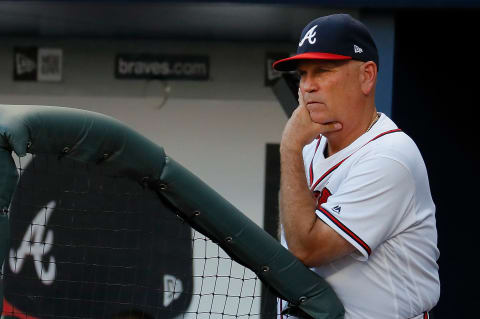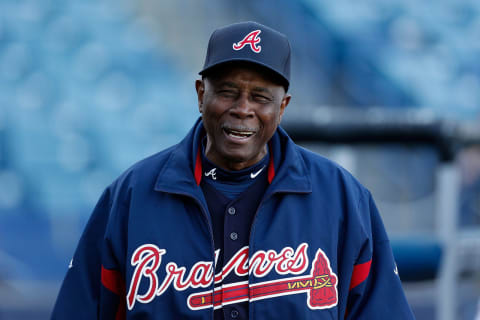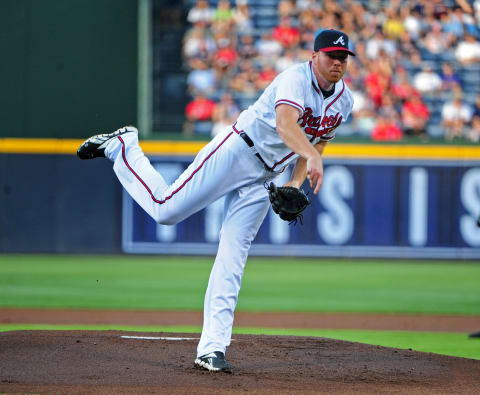Atlanta Braves Opening Day countdown: 48, Managers and more


The number 48 brings up a number of key Atlanta Braves memories. We’re going to try to cover four of them!
In our countdown to Opening Day, some days have multiple players, statistics, or notable things about the Atlanta Braves franchise that associate with the number. The number 48 has a number of big pieces to it.
Managers
Those who are younger will find the fact that the Atlanta Braves franchise has employed 48 managers in its history a seemingly gigantic number. Heck, a child born before the 1991 season had only known three managers of the Atlanta Braves in his or her entire lifetime, so even though the franchise dates back well into the 19th century, totaling 48 seems extreme.
Just to show how the tenures of a number of these managers lasted, Brian Snitker has managed for less than two full seasons in the major leagues, yet his 448 games managed with the Braves has him ranked 17th among the 48 managers in the history of the organization’s history. By the end of 2019, he will be #13.
Here are some interesting statistics among the managers that have led the Atlanta Braves franchise over the years.
- 12 have made the Hall of Fame as either a player or a manager
- Only two managed for more than 10 seasons – Bobby Cox and Frank Selee
- Two managers only lasted 1 game, and both during the 1977 season – Ted Turner and Vern Benson
- While Bobby Cox leads the Braves organization in wins and games by a significant amount, he ranks highly all-time in all MLB as well, ranking 4th in wins and 4th in games managed in MLB history
- 18 managers in franchise history have a career winning percentage over .500
- 22 of the managers for the franchise also played for the franchise at one point as a player
So now that we’ve gone through the managers, let’s look at three important players who the 48 is associated with:

Former star
In the 1940s, Andy Pafko was a star with the Chicago Cubs. He made All-Star teams in four seasons. He played both outfield and third base for the Cubs in that time, peaking in 1950, when he hit .304/.397/.591 with 36 home runs.
Pafko enjoyed his second 30 home run season in 1951 as he was traded from the Cubs to the Brooklyn Dodgers. Pafko spent another year in 1952 with the Dodgers before being traded to the Milwaukee Braves before the 1953 season.
With the Braves, Pafko spent just two seasons as a full-time starter in 1953 and 1954, but then he settled into a role as an important backup for 5 more seasons. Pafko made 10 appearances over 14 games in the 1957 and 1958 World Series between the Braves and Yankees.
Over his 7 seasons with the Braves, Pafko hit .275/.324/.411 with 50 home runs over 658 games.
Speedy
In the 3rd round of the 1967 June draft, the Atlanta Braves drafted Ralph Garr from Grambling State. The incredibly speedy outfielder showed very well in the minor leagues, but it didn’t translate right away in the major leagues. When he finally got that to click, he hit the ground running in 1971, hitting .343/.372/.441 with 9 home runs and 30 stolen bases.
That led to a tremendous run for Garr over the next 5 seasons. From 1971-1975, Garr averaged a .319/.352/.434 line with 26 doubles, 8 triples, 10 home runs, and 26 stolen bases.
In his Atlanta Braves career, Garr won a batting title and made an All-Star team. In December of 1975, the Braves traded him to the Chicago White Sox as part of a 5-player trade.

Big Red
One of the most tragic stories in recent Atlanta Braves memory is Tommy Hanson. Hanson was drafted by the Atlanta Braves in the 22nd round of the 2005 draft out of community college in California.
Just 19 in his pro debut, Hanson opened his Braves career in Danville and was dominant, posting a 2.09 ERA over 51 2/3 innings, posting a 9/56 BB/K ratio. He pushed through both A-ball levels in 2007 at 20, posting a 3.32 ERA over 133 combined innings with a 58/154 BB/K.
The 2008 season is what really put Tommy on the national map. He worked up to AA, posting a combined 2.41 ERA and 52/163 BB/K over 138 innings. He then went to the Arizona Fall League and was absolutely incredible, posting a 0.63 ERA over 28 2/3 innings, with a dominant 7/49 BB/K.
More from Tomahawk Take
- Atlanta Braves 2012 Prospect Review: Joey Terdoslavich
- Braves News: Braves sign Fuentes, Andruw’s HOF candidacy, more
- The Weakest Braves Homers Since 2015
- Atlanta Braves Sign Joshua Fuentes to Minor League Deal
- Braves News: New Year’s Eve comes with several questions about the 2023 Braves
It took just 11 dominant starts at AAA (1.49 ERA, 17/90 BB/K over 66 1/3 innings) to realize Hanson was ready for the big leagues in 2010, and he had an incredible rookie season, going 11-4 over 21 starts, pitching 127 2/3 innings, with a 2.89 ERA and a 46/116 BB/K.
Sadly, Tommy felt the Atlanta Braves were not treating him correctly by automatically renewing his contract each spring, and he was public about his intention to leave after free agency. Rather than lose Hanson for nothing, the Braves traded him before the 2013 season. Hanson ended up suffering an injury in 2013 and he was never able to get back to the major leagues.
As a member of the Atlanta Braves, Hanson made 108 starts, tossing 635 innings, with a 3.61 ERA and a 219/592 BB/K ratio.
dark. Next. A different Braves target?
Tragically, losing baseball put Hanson into a terrible place where he was abusing drugs and alcohol, leading to a final overdose that took his life in November of 2015. He was just 29.